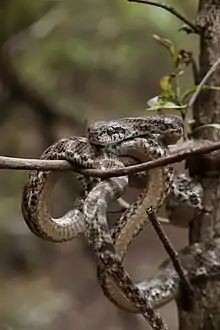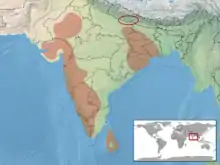Boiga forsteni
Boiga forsteni, also known commonly as Forsten's cat snake, is a species of mildly venomous rear-fanged snake in the family Colubridae. The species is endemic to South Asia.[3]
.jpg.webp)
| Boiga forsteni | |
|---|---|
 | |
| Scientific classification | |
| Domain: | Eukaryota |
| Kingdom: | Animalia |
| Phylum: | Chordata |
| Class: | Reptilia |
| Order: | Squamata |
| Suborder: | Serpentes |
| Family: | Colubridae |
| Genus: | Boiga |
| Species: | B. forsteni |
| Binomial name | |
| Boiga forsteni | |
 | |
| Synonyms[2] | |
| |
Geographic range
Boiga forstenii is found in Nepal, Sri Lanka, and India (Sikkim, West Bengal, Maharashtra, Gujarat, Kerala, Uttar Pradesh to Bihar, Madhya Pradesh, Orissa, Andhra Pradesh, Tamil Nadu, southern Rajasthan, Uttarakhand, and Jharkhand).[3]
Etymology
The specific name, forstenii, is in honor of Dutch naturalist Eltio Alegondas Forsten (1811–1843).[4]
Description
- See snake scales for terms used
In B. forsteni the anterior palatine and mandibular teeth are considerably larger than the others. The eye is about as long as its distance from the nostril.
The rostral scale is broader than it is deep, and the internasals are much shorter than the prefrontals. The frontal is nearly as long as its distance from the end of the snout, which is shorter than the parietal scales. The loreal is square or deeper than it is long. There is one preocular scale, extending to the upper surface of the head, and two or three postoculars. The temporal scales are very small and numerous. There are eight to eleven upper labials, with the third, fourth and fifth, or the fourth fifth and sixth entering the eye. There are three or four lower labials, in contact with the anterior chin shields, which are about as long as the posterior. The ventral scales number 259–270, the anal is entire, and the subcaudals number 106–131.
The body is laterally compressed. The dorsal scales are in 25 or 27 rows at midbody, disposed obliquely, and the vertebral row is feebly enlarged. The snake is brown above, with more or less regular angular black crossbars, with or without white spots between them. There is a black band from the frontal shield to the nape and another on each side behind the eye. The lower parts are white, uniform or spotted with brown.
The longest specimen examined by Boulenger in 1890 had a total length of 4 feet 10 inches (1.47 m), including a tail which was 1 ft (30 cm) long.[5] According to Das (2002) maximum snout–vent length (SVL) is 2.3 m (7.5 ft).[6]
Habitat
The preferred habitats of B. forsteni are lowland forests and agricultural areas.[6]
Reproduction
B. forsteni is an oviparous species. Sexually mature females lay 5–10 eggs. In India the eggs are laid in August and September.[6]
References
- Mohapatra, P.; Srinivasulu, C.; Suraj, M.; Wickramasinghe, L.J.M.; Ganesh, S.R. (2021). "Boiga forsteni ". IUCN Red List of Threatened Species. 2021: e.T176621A1441864. doi:10.2305/IUCN.UK.2021-3.RLTS.T176621A1441864.en. Retrieved 30 October 2022.
- Smith MA (1943). The Fauna of British India, Ceylon and Burma, Including the Whole of the Indo-Chinese Sub-region. Reptilia and Amphibia, Vol. III.—Serpentes. London: Secretary of State for India. (Taylor and Francis, printers). xii + 593 pp. (Boiga forsteni, pp. 358-359).
- Boiga forsteni at the Reptarium.cz Reptile Database. Accessed 14 February 2019.
- Beolens, Bo; Watkins, Michael; Grayson, Michael (2011). The Eponym Dictionary of Reptiles. Baltimore: Johns Hopkins University Press. xiii + 296 pp. ISBN 978-1-4214-0135-5. (Boiga forsteni, p. 92).
- Boulenger GA (1890). The Fauna of British India, Including Ceylon and Burma. Reptilia and Batrachia. London: Secretary of State for India in Council. (Taylor and Francis, printers). xviii + 541 pp. (Dipsas forstenii, p. 362).
- Das I (2002). A Photographic Guide to Snakes and other Reptiles of India. Sanibel Island, Florida: Ralph Curtis Books. 144 pp. ISBN 0-88359-056-5. (Boiga forsteni, p. 23).
Further reading
- Anderson J (1871). "On some Indian reptiles". Proceedings of the Zoological Society of London 1871: 149–211. (Dipsas forsteni, p. 187).
- Boulenger GA (1896). Catalogue of the Snakes in the British Museum (Natural History). Volume III., Containing the Colubridæ (Opisthoglyphæ and Proteroglyphæ) .... London: Trustees of the British Museum (Natural History). (Taylor and Francis, printers). xiv + 727 pp. + Plates I–XXV. (Dipsadomorphus forsteni, p. 80).
- Duméril A-M-C, Bibron G, Duméril A[-H-A] (1854). Erpétologie générale ou histoire naturelle complète des reptiles. Tome septième [Volume 7]. Deuxième partie. Comprenant l'histoire des serpents venimeux. Paris: Librairie Encyclopédique de Roret: xii + 781–1536. (Triglyphodon forsteni, new species, pp. 1077–1078). (in French).
- Günther ACLG (1864). The Reptiles of British India. London: The Ray Society. (Taylor and Francis, printers). xxvii + 452 pp. + Plates I–XXVI. (Dipsas forsteni, p. 309).
- Wall F (1921). Ophidia Taprobanica or the Snakes of Ceylon. Colombo, Ceylon [Sri Lanka]: Colombo Museum. (H.R. Cottle, Government Printer). xxii + 581 pp. (Dipsadomorphus forsteni, pp. 285–289).
